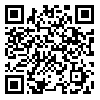BibTeX | RIS | EndNote | Medlars | ProCite | Reference Manager | RefWorks
Send citation to:
URL: http://mjiri.iums.ac.ir/article-1-3158-en.html
Background: This study compares the clinical characteristics of patients with mesial temporal lobe epilepsy with hippocampal sclerosis (mTLE-HS) with those who have temporal lobe epilepsy (TLE) due to other etiologies.
Methods : In this retrospective study all patients with a clinical diagnosis of TLE were recruited in a referral outpatient epilepsy clinic at Shiraz University of Medical Sciences from September 2008 to May 2013. We classified the patients with TLE as having mesial temporal sclerosis if they had clear signs of mesial temporal sclerosis and/or atrophy in their MRI and others who had any other MRI abnormality.
Results : A total of 174 patients were studied (including 105 patients with mTLE-HS and 69 patients with TLE due to other etiologies). Frequency of seizure types was not significantly different between these two groups. Earlier age at epilepsy onset (p= 0.005), a past history of febrile seizures (p= 0.010) and presence of affective auras (p= 0.008) were commonly seen in patients with mTLE-HS, while auditory auras (p= 0.020) were more frequent in those with TLE due to other etiologies.
Conclusion : The mainstay for making a correct diagnosis, when evaluating a patient with seizure, is having a standardized approach, particularly with regard to taking a detailed clinical history. One may find important clues in the clinical history (e.g., age at disease onset, detailed seizure description and past history) to make a correct diagnosis.
| Rights and permissions | |
 |
This work is licensed under a Creative Commons Attribution-NonCommercial 4.0 International License. |





